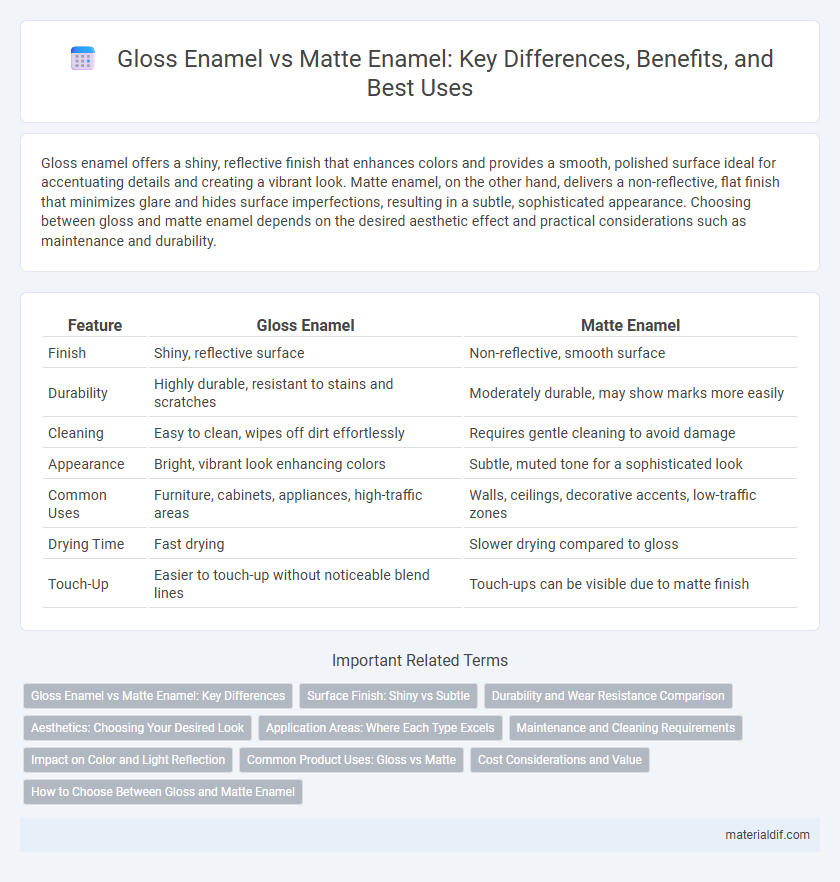Gloss enamel offers a shiny, reflective finish that enhances colors and provides a smooth, polished surface ideal for accentuating details and creating a vibrant look. Matte enamel, on the other hand, delivers a non-reflective, flat finish that minimizes glare and hides surface imperfections, resulting in a subtle, sophisticated appearance. Choosing between gloss and matte enamel depends on the desired aesthetic effect and practical considerations such as maintenance and durability.
Table of Comparison
| Feature | Gloss Enamel | Matte Enamel |
|---|---|---|
| Finish | Shiny, reflective surface | Non-reflective, smooth surface |
| Durability | Highly durable, resistant to stains and scratches | Moderately durable, may show marks more easily |
| Cleaning | Easy to clean, wipes off dirt effortlessly | Requires gentle cleaning to avoid damage |
| Appearance | Bright, vibrant look enhancing colors | Subtle, muted tone for a sophisticated look |
| Common Uses | Furniture, cabinets, appliances, high-traffic areas | Walls, ceilings, decorative accents, low-traffic zones |
| Drying Time | Fast drying | Slower drying compared to gloss |
| Touch-Up | Easier to touch-up without noticeable blend lines | Touch-ups can be visible due to matte finish |
Gloss Enamel vs Matte Enamel: Key Differences
Gloss enamel features a shiny, reflective finish that enhances color vibrancy and offers superior durability against moisture and stains. Matte enamel provides a non-reflective, smooth surface that conceals imperfections better but may be less resistant to scrubbing and discoloration. Choosing between gloss and matte enamel depends on desired aesthetics, maintenance preference, and the specific application environment.
Surface Finish: Shiny vs Subtle
Gloss enamel features a highly reflective, shiny surface finish that enhances color vibrancy and highlights texture details, making it ideal for decorative and protective applications requiring visual impact. Matte enamel offers a subtle, non-reflective surface finish that reduces glare and fingerprints, providing a smooth, muted look preferred for minimalist and contemporary designs. Both finishes deliver durable enamel protection but differ significantly in aesthetic appeal and light interaction.
Durability and Wear Resistance Comparison
Gloss enamel offers superior durability and wear resistance due to its hard, smooth surface that repels dirt and resists scratches more effectively than matte enamel. Matte enamel, while providing a sophisticated, non-reflective finish, typically exhibits lower resistance to abrasion and tends to show wear and staining more visibly over time. Choosing gloss enamel is ideal for high-traffic areas requiring long-lasting protection, whereas matte enamel suits decorative applications where subtle aesthetics are prioritized over maximum durability.
Aesthetics: Choosing Your Desired Look
Gloss enamel offers a shiny, reflective finish that enhances colors and adds a vibrant, polished appearance to surfaces, making spaces appear brighter and more lively. Matte enamel provides a non-reflective, smooth finish that creates a muted, sophisticated aesthetic, ideal for hiding imperfections and achieving a modern, understated look. Selecting between gloss and matte enamel depends on the desired visual impact and the environment where the finish will be applied.
Application Areas: Where Each Type Excels
Gloss enamel is highly favored for its reflective, shiny finish that enhances durability in high-traffic areas, making it ideal for doors, trim, and cabinetry where easy cleaning and moisture resistance are critical. Matte enamel offers a non-reflective, smooth surface that excels in hiding imperfections and is commonly used in interior walls, ceilings, and furniture to create a subtle, sophisticated look with minimal glare. Both coatings provide strong protection, but gloss enamel suits surfaces exposed to wear and frequent washing, while matte enamel enhances aesthetic appeal in low-maintenance spaces.
Maintenance and Cleaning Requirements
Gloss enamel offers a smooth, shiny surface that resists stains and is easier to wipe clean, making it ideal for high-traffic or frequently used areas. Matte enamel, with its non-reflective finish, tends to hide imperfections but can be more prone to showing dirt and fingerprints, requiring gentler cleaning methods to prevent surface damage. Both finishes benefit from regular dusting and mild detergents, but gloss enamel generally demands less maintenance to maintain its pristine appearance.
Impact on Color and Light Reflection
Gloss enamel produces a shiny, reflective surface that enhances color vibrancy by intensifying light reflection, making hues appear brighter and more saturated. Matte enamel absorbs light instead of reflecting it, resulting in a softer, muted color effect with reduced glare and less pronounced shadows. The choice between gloss and matte enamel significantly influences visual perception, where gloss emphasizes brightness and sharpness, while matte provides subtlety and depth.
Common Product Uses: Gloss vs Matte
Gloss enamel is commonly used for surfaces requiring a durable, high-shine finish such as kitchen cabinets, metal fixtures, and automotive parts, enhancing aesthetic appeal while providing resistance to moisture and stains. Matte enamel is preferred for interior walls, furniture, and decorative items where a non-reflective, smooth look is desired, offering a subtle elegance and better concealment of surface imperfections. Both finishes utilize alkyd or water-based formulations optimized for hardness and adhesion, but selection depends on the desired visual effect and functional requirements.
Cost Considerations and Value
Gloss enamel typically costs more than matte enamel due to its complex manufacturing process and higher durability, making it a popular choice for surfaces requiring frequent cleaning. Matte enamel, while generally less expensive, offers a subdued finish that may attract fewer fingerprints and scratches, potentially reducing maintenance costs over time. Choosing between gloss and matte enamel involves balancing upfront expenses with long-term value based on surface use and aesthetic preferences.
How to Choose Between Gloss and Matte Enamel
Choosing between gloss and matte enamel depends on the desired aesthetic and functional needs of the project. Gloss enamel offers a shiny, reflective finish that enhances color vibrancy and is easier to clean, making it ideal for high-traffic areas or surfaces prone to dirt. Matte enamel provides a soft, non-reflective surface that hides imperfections better and suits spaces requiring a subtle, elegant look with less glare.
Gloss enamel vs Matte enamel Infographic

 materialdif.com
materialdif.com